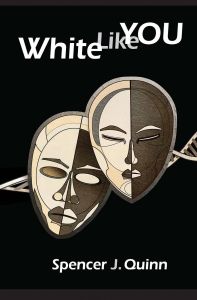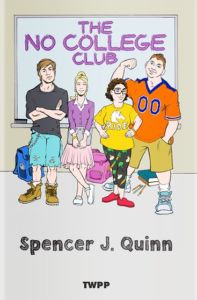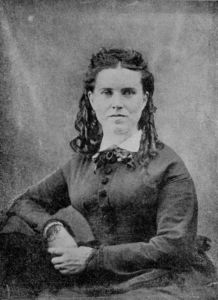The Captivity Narrative of Fanny Kelly
Posted By Spencer J. Quinn On In North American New Right | Comments Disabled2,865 words
Captivity narratives, especially those written by women, were a staple of American literature during the nineteenth century. Stories of white women captured and abused by savage Indians certainly inspired enough fascination and horror in the American public to warrant its own literary genre [2]. And for good reason, considering that there had been thousands of white captives throughout American history up to 1900, and the abuse they in many cases suffered was a fate worse than death [3].
We all know what that means, of course. They knew it back then as well. This being the Victorian era, however, that didn’t stop many of the surviving captives from being somewhat cagey about their ordeals. They had their honor and status as ladies to consider after being restored to white society. One of the most well-known of these authors was Fanny Kelly, who was emigrating to Montana with her family and several others in the summer of 1864 when over 200 Blackfeet Sioux Indians attacked their wagon train. The assault happened near the Little Box Elder Creek in Wyoming. The Indians first surrounded the emigrants, initially feigning friendship. They demanded food, then gifts, then horses, and then began the slaughter. They killed four men and took Kelly, her adopted eight-year-old niece, a woman named Sarah Larimer, and her young son as captives. Three men, including the husbands of both women and one Negro slave, managed to escape.
Kelly ended up spending five months in captivity, and in 1871 published an account of her experiences entitled Narrative of my Captivity Among the Sioux Indians. The narrative is striking for many reasons, not least of which is its poignancy and detail. Aside from its gripping suspense and many evocative passages, it can serve as a testament to the mores and attitudes of white Americans from the time as well as an ethnology of the Blackfeet Sioux. For example, Kelly knew that the peculiar marks on their arrows meant that “their owners had all belonged to one tribe, though of different bands.” She also observed them firsthand in all their wanton cruelty and does not hold back in her memoir:
I thought of all the characters of romance and history, wherein the nature of the red man is enshrined in poetic beauty. The untutored nobility of soul, the brave generosity, the simple dignity untrammeled by the hollow conventionalities of civilized life, all rose mockingly before me, and the heroes of my youthful imagination passed through my mind in strange contrast with the flesh and blood realities into who hands I had fallen.
Kelly later underscores the theory-versus-experience divide which has long pitted whites against each other in internecine conflict over the topic of race:
. . . but the true red man, as I saw him, does not exist between the pages of many volumes. He roams his native wastes, and to once encounter and study him there, so much must be sacrificed that I was unable to appreciate the knowledge I was gaining at such a price.
After burning whatever they couldn’t steal, the savages placed the two white women and their children on horses and rode off. On their way, however, Kelly surreptitiously released her niece, instructing her to lay low and then retrace her steps back to the main trail. The girl absconded successfully, but Kelly was found out when she tried to follow shortly thereafter. The Indians beat her mercilessly and then hunted down and murdered her poor niece, whom they scalped and left where they’d found her. Miraculously, however, Larimer and her child managed to escape within a couple days of capture. But in my 1990 edition, we learn this from the book’s Prologue, and not from Kelly herself, who oddly drops the Larimers from her narrative. We shall see why later.
 [4]
[4]You can buy Spencer Quinn’s novel White Like You here [5].
The Indians then led their captive through a labyrinth of craggy, rugged terrain, which Kelly describes as “inaccessible to white men.” Here, they treated her as a slave while depriving her of food and water. Death threats were constant, and rather than embrace the prospect of mortal reprieve, the thoughtful narrator gives herself up to God: “But it is only those who have looked over the dark abyss of death who know how the soul shrinks from meeting the unknown future.”
After this, we are treated to Kelly’s deft literary depictions of her experiences, memories, hopes, and anguish. She describes what the Indians wore, what they ate, how they ate, how they organized themselves, how they worshipped, how they interacted with each other, and how they interacted with their environment. She explains how Indians would chew on sticks in the oppressive heat to keep from feeling parched. She describes a scene in which she faced execution for carelessly discarding her owner’s pipe. She saved herself by showering the braves with the paper money she had stashed in her purse. In another scene, Kelly tells of a dog-feast spirit dance in which dogs and horses were sacrificed to appease offended spirits, while braves dance like “fiends in a carnival of battle” beneath human scalps fastened to poles. She also meets a mysterious Southerner who had lived among the Indians for many years and had a brood of mixed-race children. He yet remained Southern enough to claim that Richmond would never be taken. Amusingly, she also relates a story of how the Sioux tried pickles for the first time and nearly gagged at their sour taste. They tried to cook them in their glass jars, only to watch the jars explode over their fires.
In one of the most striking and surreal moments of the narrative, Kelly eloquently tells of how she and her entire band endured a three-hour thunderstorm by lying flat on the ground. This was, apparently, the way of the tribe, and a lurid experience which I am sure will remain with the reader almost as long as it did for the author herself:
When the vivid gleams lit up the air, enormous trees could be seen bending under the fierceness of the blast, and great white sheets of water burst out of the clouds, as if intent on deluging the world. Every element of nature united in terrific warfare, and the security of the earth seemed denied to me while I clung to its flooded bosom, and blinded by lightning and shocked by the incessant roaring of the thunder and the wild ravaging of the ungovernable wind, felt myself but a tossed atom in the great confusion, and could only cling to God’s remembering pity in silent prayer.
Throughout the narrative, Kelly never once questions her identity as a civilized white person and is always prepared to assert the cultural and racial gulf between her and her captors. “Their people were not my people,” she affirms in her memoir. In many places we find refreshingly overt ethnocentrism. Upon meeting another captive white woman, she writes:
It was very natural and pleasant to know her as she was white, and although she was an Indian in tastes and habits, she was my sister and belonged to my race. There was a sympathetic chord between us, and it was a relief to be with her.
Her almost clinical detachment towards the Indians produces quite a few acerbic, yet no doubt accurate, assessments of them. Of hunting buffalo, she writes:
The Indians often, for the mere sport, make an onslaught, killing great numbers of them, and then have a plentiful feast of “ta-tonka,” as they call buffalo meat. They use no economy in food. It is always a feast or a famine; and they seem equally able to gorge or fast. Each man selects the part of the animal he has killed the best suits his own taste, and leaves the rest to decay or be eaten by wolves, thus wasting their own fame, and often suffering privation in consequence.
Kelly notes the Indians’ cruelty towards animals as well as towards humans, and laments how they often whipped their dogs and horses. She remarks on their boastful, profane, hidebound, and dishonest natures, as well as their near-universal fondness for whiskey. She particularly loathed their barbaric victory celebrations, as well as their penchant for targeting white women with long hair — which made for especially gaudy scalps. She witnessed murder, torture, mutilation, and wife battery. She befriended another white captive, one Mary Boyeau — whom historians cannot find any record of elsewhere — who resentfully described her sexual bondage to the Indians, as well as a harrowing scene in which Indians burst into the home of a white woman whom they then stabbed to death. Her wailing infant they tossed into the oven. The casual and torturous murder of white infants is a common occurrence in captivity narratives. Often, mothers were forced to witness such atrocities, especially if their Indian tormentors aimed to terrorize them into submission.
Like a first-rate novelist, Kelly adroitly presents all the crucial plot twists and intrigues surrounding her rescue by American forces at nearby Fort Sully. It’s real edge-of-your-seat reading, as is her delirious disbelief at being saved (“Am I free, indeed free?”), her joyous reunion with her husband, and her devastation upon learning the tragic fate of her poor niece. Later, after her husband’s passing in 1867, Kelly was invited to stay with the Larimers in Wyoming to co-author a memoir of their time in captivity. Unfortunately, Sarah Larimer published this supposedly co-written account under her own name, which prompted Kelly to sue. Years of litigation between the two women caused them to become enemies, and is perhaps the reason why Kelly leaves Larimer’s fate open-ended in her memoir.
As for whether Fanny Kelly was sexually abused, she claims not In her narrative. However, in her 1868 petition to Congress to receive recompense for her treatment at the hands of the Blackfeet, she writes:
Your memorialist was then taken into captivity, and was forced to become the squaw of one of the O-gal-lal-lah Chiefs, who treated her in a manner too horrible to mention, and during her captivity was passed from Chief to Chief, and treated in a similar manner.
Kelly’s testimony seems to have greater credibility in this regard than the narrative itself, given its consistency with nearly all captivity narratives involving white women. Gang rapes were not only common, but expected by any unlucky white woman who was captured by Indians on the frontier back then. S. C. Gwynne says as much in his Empire of the Summer Moon [6], a history of Quanah Parker and the Comanche Indians. In 1839 Rachel Plummer, the aunt of the famous captive Cynthia Ann Parker (Quanah’s white mother, on whom the film The Searchers was loosely based) published her account of captivity in which she writes:
To undertake to narrate their barbarous treatment would only add to my present distress, for it is with feelings of the deepest mortification that I think of it, much less to speak or write of it . . .[1] [7]
George Spencer was taken captive by Indians during the great Minnesota uprising in 1862. He was treated relatively well, but recounted how
the female captives were, with very few exceptions, subjected to the most horrible treatment. In some cases, a woman would be taken out into the woods, and her person violated by six, seven, and as many as ten or twelve of these fiends.[2] [8]
14-year-old, German-born Mary Schwandt was abducted by Sioux Indians in Minnesota around this time as well. After murdering six of her family members — or seven, if you include her sister’s unborn child, which had been ripped from its mother’s womb and nailed to a tree — the savages raped her repeatedly. In her own words:
They took me out by force, to an unoccupied teepee, near the house, and perpetrated the most horrible and nameless outrages upon my person. These outrages were repeated at different times during my captivity.[3] [9]
 [10]
[10]You can buy Spencer J. Quinn’s young adult novel The No College Club here [11].
The list goes on.
Interestingly, Fanny Kelly never seemed to give in to hatred of her captors, either during her ordeal or years later, when she penned her memoir. Many other surviving captives did, however. In 1864, Laura Roper was captured by a band of Cheyenne Indians near her home in modern-day Nebraska. They slaughtered almost an entire white family before her eyes. During her abduction, a horse kicked her in the face. Of course, throughout her captivity she was continually raped, beaten, and abused. She did not forgive, and the following year wrote in a letter about how she hoped that “every one of the Indians will be extinguished.[4] [12]
Fanny Kelly for her part makes sure to depict acts of kindness from the Indians. She also specifies which ones were brave or noble enough to rise above the savage mean. Towards the end of her captivity, she writes of how she had been sold to a different tribe of Blackfeet who, while remaining militarily hostile to the whites, treated her with all the fairness and respect appropriate for an innocent civilian prisoner of war. Squaws fed her on numerous occasions and offered her companionship when she desperately needed it. Kelly had also befriended a young Indian girl shortly before her rescue.
Most importantly, Kelly gives voice to the legitimate grievance the Indians had against the whites at that time. When comforting a brave with fever, the man bemoaned how “I go to fight the white man. He take away our land and chase game away; then he take away our squaws. He take away my best squaw.” And it’s true. Fanny Kelly does comment disapprovingly on how many American soldiers on the frontier took “Indian wives” and sired children with them, only to send the whole brood back to the tribe’s village whenever their real wives came to visit.
One of the best lines in the book comes out of the mouth of an Indian:
The palefaces, our eternal persecutors, pursue and harass us without intermission, forcing us to abandon to them, one by one, our best hunting grounds, and we are compelled to seek a refuge in the depths of these Bad Lands like timid deer. Many of them even dare to come into the prairies which belong to us, to trap beaver and hunt elk and buffalo, which are our property. These undesirable creatures, the outcasts of their own people, rob and kill us when they can. Is it just that we should suffer these wrongs without complaining?
By not reaching for easy answers and by plumbing the spiritual and psychological depths of the human soul, Narrative of my Captivity Among the Sioux Indians goes well beyond what a memoir typically offers. It is so well-written that I have to say it is suspiciously well-written. Did Fanny Kelly have help? Did she hire a ghostwriter? I don’t know, but her work exhibits real talent and panache, and comfortably occupies the upper middlebrow echelons of first-person non-fiction literature. I have read several captivity narratives, and all of them belie an amateur hand between the lines. Not so with Narrative of my Captivity. If Fanny Kelly was this good, why didn’t she publish anything else?
Regardless, Fanny Kelly’s narrative was extremely popular, with my 1990 edition being the book’s eleventh printing. In her later years, she remarried and worked for the federal government in Washington, DC. She also made a small fortune in real estate and was a highly esteemed lady in her old age. According the editors of my edition, Kelly developed a real affection towards the Indians to the point of entertaining Indian dignitaries in her home when they came to Washington.
And why wouldn’t she? Aside from seeming to be a good soul, she reached her prime very close to the apogee of white civilization. She died in 1904, a decade removed from the First World War. European and American whites were the unquestioned leaders of the world at that time. Of course she would express the white man’s generosity towards his conquered enemies. It would be inhuman not to, regardless of the inhumanity the Indians had inflicted upon her and her family 40 years earlier. The whites had won. Why restart wars that had already ended?
Of course, we all know in hindsight that victory was fleeting, and that wars, especially between racial groups, are never over. 150 years ago we had captivity narratives. Today, we have the tens of thousands of white European girls and women who’ve been brutalized and enslaved by Muslim invaders [13]. Is it any different now than it was then? Yes and no. But the biggest way in which times have changed is that in Fanny Kelly’s day, white female victims were encouraged to tell their stories — as they should have been. Today, however, white women are shamed into keeping quiet, which is the one thing that will ensure that their victimization will continue.
 [14]
[14]
* * *
Like all journals of dissident ideas, Counter-Currents depends on the support of readers like you. Help us compete with the censors of the Left and the violent accelerationists of the Right with a donation today. (The easiest way to help is with an e-check donation. All you need is your checkbook.)
For other ways to donate, click here [15].
Notes
[1] [16] Rachel Plummer, Narrative of the Capture and Subsequent Sufferings of Mrs. Rachel Plummer During a Captivity of Twenty-one Months Among the Comanche Indians. 1839.
[2] [17] C. M. Oehler, The Great Sioux Uprising (New York: Oxford University Press, 1959), pp 198-199.
[3] [18] Charles S. Bryant & Abel B. Murch, A History of the Great Massacre by the Sioux Indians in Minnesota (Rickey & Carroll, Publishers, 1864). Digital scan reprint, 2001, p. 340.
[4] [19] Ronald Becher, Massacre Along the Medicine Road: A Social History of the Indian War of 1864 in Nebraska Territory (Caxton Press, 1999), pp. 326-327, 428.
